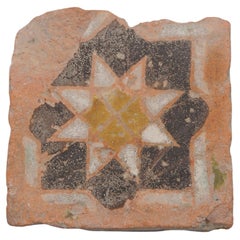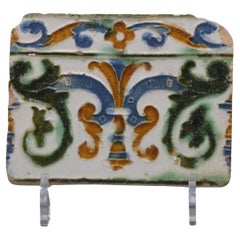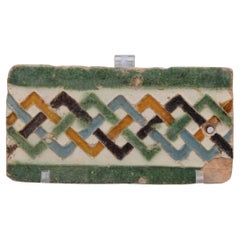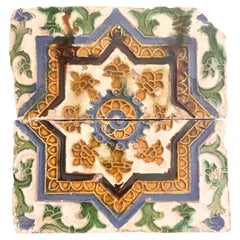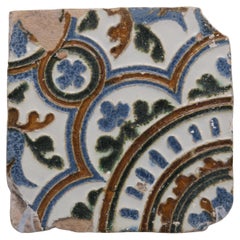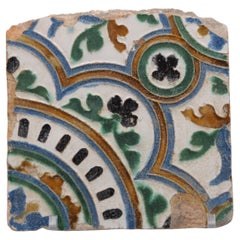16th Century Ceramics
to
1
30
424
1,422
6,894
1,812
943
4,165
1,091
122
39
278
361
203
850
1,113
504
191
73
1
30
26
13
1
1
27
3
28
23
4
1
1
30
30
30
22
1
Period: 16th Century
Spanish Moorish Mudejar Olambrilla Tile, Cuerda Seca - Toledo 15th/16th century
Located in DELFT, NL
Rare late 15th or early 16th century Mudejar tile of the so-called ‘Arista’ or 'cuerda seca' technique.
The central motif is an eight-pointed star, which in turn encloses smaller on...
Category
Spanish Renaissance Antique 16th Century Ceramics
Materials
Earthenware
Spanish Azulejo Tile Arista y Cuenca - Toledo 16th century
Located in DELFT, NL
Early Arista y cuenca tile made in Toledo. Tile decorated in renaissance with stylized flowers was probably made between 1550 and 1575.
Category
Spanish Renaissance Antique 16th Century Ceramics
Materials
Earthenware
Spanish Moorish Mudejar Tile, Arista y Cuenca - Sevilla 16th century
Located in DELFT, NL
Rare late 15th or early 16th century Mudejar tile of the so-called ‘Arista’ technique with intricate geometric decoration.
Good condition; some chipping to the edges, some wear to ...
Category
Spanish Renaissance Antique 16th Century Ceramics
Materials
Earthenware, Clay, Maiolica
Spanish Azulejo Tiles 'Dos por Tabla' - Arista y Cuenca - Toledo 16th century
Located in DELFT, NL
Set of Spanish tiles of the 'dos por tabla/ type in the Arista y cuenca tile made in Toledo. This particular type was to adorn ceilings.
Tile decorated in renaissance with stylized ...
Category
Spanish Renaissance Antique 16th Century Ceramics
Materials
Earthenware
Spanish Azulejo Tile Arista y Cuenca - Toledo 16th century
Located in DELFT, NL
Early Arista y Cuenca tile made in Toledo. Azulejo Toledano. Alhambra tile decorated in renaissance mudejar style geometrical design.
Probably made between 1550 and 1575.
In very g...
Category
Spanish Renaissance Antique 16th Century Ceramics
Materials
Earthenware, Maiolica
Spanish Azulejo Tile Arista y Cuenca - Toledo 16th century
Located in DELFT, NL
Early Arista y Cuenca tile made in Toledo. Azulejo Toledano. Alhambra tile decorated in renaissance mudejar style geometrical design.
Probably made between 1550 and 1575.
In very g...
Category
Spanish Renaissance Antique 16th Century Ceramics
Materials
Earthenware, Maiolica
Heraldic Spanish Azulejo Tile - Arista y Cuenca - Sevilla, early 16th century
Located in DELFT, NL
Important heraldic Spanish tile of the 'azulejo por tabla para techo' type, in arista y cuenca technique, made in Sevilla in the early 16th century.
Depicting a two-section tower an...
Category
Spanish Renaissance Antique 16th Century Ceramics
Materials
Earthenware
Spanish Azulejo Tile Arista y Cuenca - Toledo 16th century
Located in DELFT, NL
Early Arista y cuenca tile made in Toledo. Tile decorated in renaissance with stylized flowers was probably made between 1550 and 1575.
Category
Spanish Renaissance Antique 16th Century Ceramics
Materials
Earthenware
Spanish Azulejo Tile Arista y Cuenca - Toledo 16th century
Located in DELFT, NL
Spanish Arista Tile Fragment, Toledo, mid-16th Century (c. 1550–1575)
This tin-glazed earthenware tile fragment originates from Toledo, Spain, dated to circa 1550–1575. The ceramic ...
Category
Spanish Renaissance Antique 16th Century Ceramics
Materials
Earthenware
Spanish Azulejo Tile Arista y Cuenca - Toledo 16th century
Located in DELFT, NL
Early Arista y cuenca tile fragment made in Toledo. Tile decorated in renaissance with stylized flowers was probably made between 1550 and 1575.
Losses and wear.
Category
Spanish Renaissance Antique 16th Century Ceramics
Materials
Earthenware
Spanish Azulejo Tile Fragment Arista y Cuenca - Toledo 16th century
Located in DELFT, NL
Early Arista y cuenca tile made in Toledo. Tile decorated in renaissance style with interlacing lines ending in four stylized flowers was probably made between 1550 and 1575.
Category
Spanish Renaissance Antique 16th Century Ceramics
Materials
Earthenware
Spanish Azulejo Tile Arista y Cuenca - Toledo 16th century
Located in DELFT, NL
Early Arista y cuenca tiles made in Toledo. Tile decorated in renaissance with stylized flowers, probably made between 1550 and 1575.
I have four of them available, please reach o...
Category
Spanish Renaissance Antique 16th Century Ceramics
Materials
Earthenware, Maiolica
Spanish Moorish Mudejar Olambrilla Tile, Cuerda Seca - Sevilla 16th century
Located in DELFT, NL
Rare early 16th century Mudejar tile of the so-called ‘Aristo’ or 'cuerda seca' technique.
Polychrome tiles had long been made in Spain in the cuerda seca (dry cord) technique, dati...
Category
Spanish Renaissance Antique 16th Century Ceramics
Materials
Earthenware
Spanish Azulejo Geometric Tile Arista y Cuenca - Sevilla 16th century
Located in DELFT, NL
Rare early 16th century Mudejar tile of the so-called ‘Aristo’ or 'cuerda secca' technique
Geometric design with a central intertwining cords. Very ornate decoration.
This type of...
Category
Spanish Renaissance Antique 16th Century Ceramics
Materials
Earthenware, Maiolica
Spanish Azulejo Tile Arista y Cuenca - Sevilla 16th century
Located in DELFT, NL
Early Arista y Cuenca tile, most likely made in Sevilla. Azulejo tile decorated with a gemetric pattern with 4 central leafs within a cirlce.
Mid 16th century
In very good conditi...
Category
Spanish Renaissance Antique 16th Century Ceramics
Materials
Earthenware, Maiolica
Spanish Moorish Tile, Arista- Toledo 16th century
Located in DELFT, NL
16th century Spanish Moorish tile of the so-called ‘Arista’ technique.
Good condition; some chipping to the edges, some wear to the glaze. No restorations
Category
Spanish Renaissance Antique 16th Century Ceramics
Materials
Earthenware
Spanish Azulejo Tile Arista y Cuenca - Toledo 16th century
Located in DELFT, NL
Early Arista y cuenca tile made in Toledo. Tile decorated in renaissance with stylized flowers was probably made between 1550 and 1575.
Category
Spanish Renaissance Antique 16th Century Ceramics
Materials
Earthenware
Spanish Azulejo Tile Arista y Cuenca - Toledo 16th century
Located in DELFT, NL
Early Arista y cuenca tile made in Toledo. Tile decorated in renaissance with stylized flowers was probably made between 1550 and 1575.
Category
Spanish Renaissance Antique 16th Century Ceramics
Materials
Earthenware
Italian Renaissance Plate, Patanazzi Workshop Urbino, End of 16th Century
Located in Milano, IT
Acquareccia plate
Patanazzi workshop
Urbino, last quarter of the 16th century
It measures diameter 17.12 in; foot diameter 11.53 in; height 1.88 in (43.5 cm; 29.3 cm; 4.8 cm).
Weight
State of conservation: wear and a few small minimal detachments of enamel, chipping on the raised areas, peeling of enamel at the brim on the back.
This large, shallow basin is equipped with a wide and convex well. It is umbonate with a contoured center. The brim, short and flat, is enclosed in a double rounded and barely raised edge. The basin has a flat base without rims; it has a slightly concave center in correspondence to the well.
The shape takes inspiration from the basins associated with the metal forged amphora pourers that traditionally adorned the credenza. These were used from the Middle Ages to wash hands during banquets. Two or three people washed their hands in the same basin and it was considered an honor to wash one’s hands with an illustrious person.
The decoration is arranged in concentric bands with, in the center of the umbo, an unidentified shield on a blue background: an oval banded in gold with a blue head, a gold star and a field with a burning pitcher.
Rings of faux pods separate the center from a series of grotesque motifs of small birds and masks. These go around the basin and are, in fact, faithfully repeated on the brim. The main decoration develops inside the flounce of the basin, which sees alternating symmetrical figures of winged harpies and chimeras. The ornamentation, outlined in orange, green and blue, stands out against the white enamel background.
This decorative style, defined since the Renaissance as “grottesche” or “raffaellesche”, refers to the decorations introduced after the discovery of the paintings of the Domus Aurea towards the end of the fifteenth century. The discovery of Nero's palace, buried inside Colle Oppio by damnatio memoriae, occurred by chance when a young Roman, in 1480, fell into a large crack which had opened in the ground on the hill, thus finding himself in a cave with walls covered with painted figures.
The great artists present in the papal city, including Pinturicchio, Ghirlandaio, Raffaello, immediately visited these caves. The decorations found there soon became a decorative subject of immense success: the term grotesque , with the meaning of “unusual,” “caricatured,” or “monstrous,” was later commented by Vasari in 1550 as “una spezie di pittura licenziose e ridicole molto”( “a very licentious and ridiculous kind of painting”).
The decorations “a grottesche” also widely circulated in ceramic factories, through the use of engravings, variously interpreted according to the creativity of the artists or the requests of the client.
Our basin is reflected in similar artifacts produced at the end of the sixteenth century by the factories of the Urbino district. See the series of basins preserved in the main French museums, among which the closest in morphology is that of the Campana collection of the Louvre (Inv. OA1496); this however has a more complex figure decoration, while the decoration of our specimen is sober and with a watercolor style.
The style, sure in its execution, approaches decorative results still close to the works produced around the middle of the sixteenth century by the Fontana workshop. The decoration is closely linked to their taste, which later finds its natural outlet, through the work of Antonio, also in the Patanazzi workshop. Studies show the contiguity between the two workshops due to the kinship and collaboration between the masters Orazio Fontana and Antonio Patanazzi, both trained in the workshop of Guido Fontana il Durantino. It is therefore almost natural that their works, often created according to similar typologies and under the aegis of the same commissions, are not always easily distinguishable, so much so that the presence of historiated or “grottesche” works by Orazio is documented and preserved in Antonio Patanazzi's workshop. Given that the studies have always emphasized the collaboration between several hands in the context of the shops, it is known that the most ancient “grottesche” works thus far known, can be dated from 1560, when the Fontana shop created the so-called Servizio Spagnolo (Spanish Service) and how, from that moment on, this ornamentation became one of the most requested by high-ranking clients. We remember the works created for the Granduchi di Toscana, when Flaminio Fontana along with his uncle Orazio supplied ceramics to Florence, and, later, other commissions of considerable importance: those for the service of the Duchi d’Este or for the Messina Farmacia of Roccavaldina, associated with the Patanazzi workshop when, now after 1580, Antonio Patanazzi began to sign his own work.
Thus, in our basin, the presence of masks hanging from garlands, a theme of more ancient memory, is associated in the work with more advanced stylistic motifs, such as the hatching of the chimeras and harpies. These are found here on the front with the wings painted in two ornate ways. In addition, the theme of the birds on the edge completes the decoration along the thin brim and can be seen as representing an early style typical of the Urbino district during a period of activity and collaboration between the two workshops. Later, a more “doll-like” decorative choice, typical of the end of the century and the beginning of the seventeenth century, characterized the period of the Patanazzi workshop under the direction of Francesco.
Bibliography:
Philippe Morel, Il funzionamento simbolico e la critica delle grottesche nella seconda metà del Cinquecento, in: Marcello Fagiolo, (a cura di), Roma e...
Category
Italian Renaissance Antique 16th Century Ceramics
Materials
Maiolica
Spanish Azulejo Tile Arista / Cuenca - Toledo 16th century
Located in DELFT, NL
Early Arista / border tile made in Toledo. Tile decorated in renaissance with stylized flowers was probably made between 1550 and 1575.
Catalogue: La Azulejería Toledana a Través ...
Category
Spanish Renaissance Antique 16th Century Ceramics
Materials
Earthenware
Ancient Italian Renaissance Maiolica Crespina, Faenza, 1580 Circa
Located in Milano, IT
Crespina
Faenza, last quarter of the 16th century
Maiolica painted in two colors, light blue and yellow, on a thick, rich layer of white enamel.
It measures 2.24 in (5.7 cm) in height, 6.10 in (15.5 cm) in diameter.
lb 0.55 (kg 0.25)
State of conservation: mimetic restoration.
The small cup has a raised central “umbone”, a perforated brim and a shaped rim. It rests on a high jutting foot. The "crespina" shape, in some inventories is cited as "tacce de frute" (fruit cups). It was particularly appreciated in the Renaissance and has variants based on the formal types and the different sizes. The decoration, made according to the dictates of the “compendiario” style, used few standardized colors: blue and yellow on a thick white and shiny enamel, deliberately chosen as the colour which was most reminiscent of silver. This choice derived from a trend in creative design of the era: the shapes used in the molds were often taken from metal objects. An idea which would last throughout the Renaissance.
The work shows, in the middle of the “umbone”, a winged putto stepping forward while playing a long thin trumpet.
The depiction of the putto is fully representative of the repertoire of the Faenza workshops of the sixteenth century.
Some specimens with this type of decoration have been published in a volume by Carmen Ravanelli Guidotti: there appears the whole productive repertoire of this fundamental moment of transition between the taste for the “istoriato” style and the great simplification of decoration in the “compendiario” period. This style, in its simplicity, however, saw its expression in a rather varied collection of decorative subjects, including old-fashioned busts...
Category
Italian Renaissance Antique 16th Century Ceramics
Materials
Maiolica
Spanish Azulejo Tile Arista y Cuenca - Toledo 16th century
Located in DELFT, NL
Early Arista y cuenca tiles made in Toledo. Tile decorated in renaissance with stylized flowers, probably made between 1550 and 1575.
I have four of them available, please reach o...
Category
Spanish Renaissance Antique 16th Century Ceramics
Materials
Earthenware, Maiolica
Extremely Rare Islamic Safavid Blue and White Large Dish Persian 16th Century.
Located in Vero Beach, FL
Extremely Rare Islamic Safavid Blue and White Large Dish Persian 16th Century.
This Safavid fritware dish is painted under the glaze in black and coba...
Category
Islamic Antique 16th Century Ceramics
Materials
Ceramic
(4) Four Portuguese Tiles, 16th Century (1530/1550) Very Rare Collection Items
Located in Madrid, ES
(4) Four Portuguese Tiles, 16th Century (1530/1550) Very Rare Collection Items
Each tile 14cm x 14cm
Original, unrestored
They are very rare, they are collection items, museum ite...
Category
Portuguese Baroque Antique 16th Century Ceramics
Materials
Ceramic
Spanish Azulejo set of 4 tiles Arista y Cuenca - Toledo 16th century
Located in DELFT, NL
Set of 4 early Arista y cuenca tiles made in Toledo. Tile decorated in renaissance with stylized flowers, probably made between 1550 and 1575.
condition: 3 are in very good conditi...
Category
Spanish Renaissance Antique 16th Century Ceramics
Materials
Earthenware, Maiolica
Spanish Azulejo pair of Tiles Arista y Cuenca - Toledo 16th century
Located in DELFT, NL
Early Arista y cuenca tiles made in Toledo. Tile decorated in renaissance with stylized flowers, probably made between 1550 and 1575.
Also separately available, please reach out t...
Category
Spanish Renaissance Antique 16th Century Ceramics
Materials
Earthenware, Maiolica
Pair of Ming Dynasty Bowls with Pattern of Interlocking Hexagons
Located in Atlanta, GA
Pair of Ming Dynasty Bowls with Pattern of Interlocking Hexagons, Wanli period (1572-1620).
This handsome pair of bowls with a slightly fluted rim features an outer pattern of hexago...
Category
Chinese Ming Antique 16th Century Ceramics
Materials
Porcelain
$1,500 Sale Price / set
39% Off
Small Maiolica Plate, Urbino District, 1533-1555
Located in Milano, IT
Maiolica plate (tondino)
Urbino district, Casteldurante or Pesaro, 1533-1555
It measures: diam. 7.48 in (19 cm), foot diam. 2.75 in (7 cm), height 1.0...
Category
Italian Renaissance Antique 16th Century Ceramics
Materials
Maiolica
16th Century Spanish Valencian Manises Lusterware Ceramic Plate
Located in Marbella, ES
16th century Spanish Valencian Manises lusterware plate combining ceramics with metallic glaze.
It has been repaired with iron grapples.
Category
Spanish Antique 16th Century Ceramics
Materials
Iron
16th Century Castelli Italian Maiolica Farnese alla turchina Dish
By Castelli
Located in Fort Lauderdale, FL
An extraordinary azure maiolica dish in the Farnese service, made by Castelli d'Abuzzo between 1580 and 1589.
In the peak of the High Renaissance, Cardinal Alessandro Farnese commissioned a dinner service from the Castelli maiolica...
Category
Italian Renaissance Antique 16th Century Ceramics
Materials
Maiolica
Recently Viewed
View AllMore Ways To Browse
18 Century Tea Table
18th Century Dutch Delft Shoes
Aj Wilkinson
Aldo Rossi Rosenthal
Antique 1 Gallon Crock
Antique Ceramic Jelly Moulds
Antique Chinese Green Ginger Jar
Antique Majolica Sardine Box
Arabia Tile Finland
Aspic Mold
Atelier Claude Tabet
Barnyard King
Benedicte Vallet
Bjorn Wiinblad Pitcher
Blue Willow Japan
Blue Willow Ridgway
Bow Porcelain Mug
Brian Kelly
